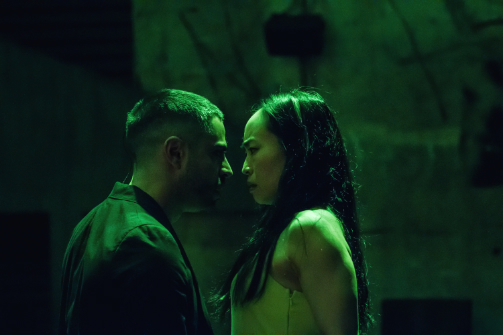Mourning Becomes Electra
By Eugene O'Neill; Directed by David Herskovits
Produced by Target Margin Theater
Off Off Broadway, Play Revival
Runs through 5.20.17
Abrons Arts Center, 466 Grand Street
by Ran Xia on 5.4.17
 Satya Bhabha and Eunice Wong in Mourning Becomes Electra. Photo by Kelly Stuart.
Satya Bhabha and Eunice Wong in Mourning Becomes Electra. Photo by Kelly Stuart.
BOTTOM LINE: Jealousy is a ruthless murderess in Target Margin Theater's attempt to achieve a simultaneously grand and intimate production of Eugene O'Neill's expansive trilogy.
There’s always a song in a story like this. It's an old story, a story of murder and intrigue, a bloodline of jealousy and terrible deeds, sealed with an enchanted ditty, like a spirit lurking in the cracks of time, and it’s waiting to be awakened by the same melody. That’s how Mourning Becomes Electra begins—with “O Shenandoah” in old man Seth (Mary Neufeld)’s broken voice—and it opens a door to the past, the door to the Mannon house: a dilapidated sight of its bygone grandeur. The supreme judge’s house imitates that of an ancient Greek courthouse, with its perfectly symmetrical structure and ionic columns. Portraits of the Mannon patriarchs (going back for generations) hang in prominent positions, and the selfsame face watches over it all: Ezra Mannon’s name centers that lineage of stern, frozen faces, a presence that remains constant in this nasty web of intrigue.
In Mourning Becomes Electra, Eugene O’Neill transplants Aeschylus’ Oresteia trilogy into Civil War-era America. In O'Neill's first part, Homecoming (the parallel to Aeschylus' Agamemnon), Agamemnon’s victorious return becomes Ezra Mannon’s homecoming in the spring of 1865. The Mannon household staff and townsfolk (replacing a Greek Chorus) await the return of their master while gossiping about the affair between Ezra's wife Christine (Stephanie Weeks) and ship captain Adam Brant (Satya Bhabha). And the adulterers soon plot Ezra’s murder. For Christine, it’s out of the sheer desire to escape her stifling marriage, and for Brant, it's out of jealousy.
Weeks’ Christine channels a cunning Lady Macbeth-type who prefers to be adorned in gem-toned gowns (Kaye Voyce’s dazzling costume designs), a stark contrast to her daughter Lavinia "Vinny" Mannon (Eunice Wong). Wong's portrayal of the Mannon daughter is sublime. Shortly before the murder, when Christine and Ezra share a bed for the last time, Lavinia looms in the background, looking like a Civil War-era Wednesday Adams. Her presence is reserved yet magnetic, like a spider sitting at the center of an intricate web. The almost incestuous attachment between Ezra and Lavinia also forebodes tragedy.
The Hunted (O'Neill's version of The Libation Bearers) begins with the return of the prodigal son. Orin (Satya Bhabha again), wounded and disillusioned by the war, comes home to the news of his father’s death; a chess game of power between Christine and Lavinia ensues. Both possessive of Orin’s attention and wanting to one up the other, Christine tries to make Orin alienate Lavinia, and Lavinia in turn tries to drive a wedge between Christine and her son. The sexually charged chemistry between mother and son, sister and brother, would make even Doctor Freud's stomach turn. Lavinia wins this round by proving to Orin their mother’s affair, which leads to Orin’s crime of passion against the ship captain. Aside from the family drama, Orin’s PTSD is also reflected beautifully. “Death becomes the Mannons,” he exclaims, before recalling his experience during the war; he comes to the conclusion that the war meant murdering the same man again and again until he had killed himself.
And finally, The Haunted (corresponding to The Eumenides) begins with yet another homecoming. One year later, the Mannon siblings return from their trip East. While Orin is still stricken by guilt over his mother’s death, Lavinia is transformed. Gone are the monochromatic dark clouds she used to wrap herself in, as well as her military stiffness. Now she resembles her mother in style and has gained a newfound confidence; Orin accuses her of being turned into a "real romantic" by their island vacation. The siblings' relationship now almost parallels that of their parents, as Orin suggests that death has set Lavinia free to become Christine. Orin makes an effort to repent by writing down the Mannon family history, yet is ultimately dissuaded by his sister. Appropriately reflecting the title of the play, Weeks’s Christine walks unseen during The Haunted, making her appearance indeed like that of a ghost. Also haunting the house is Ezra Mannon and the rest of the family ghosts. The Mannon portraits (those faces carved out of stone are still present) at times appear alive, thanks to Lenore Doxsee and Sarah Lurie's genius lighting design.
Director Herskovits trims the size of the ensemble quite a bit for this production. Besides the Mannon tribe, Kristen Calgaro, Avi Glickstein, and Mary Neufeld make up a powerful three-person chorus. Neufeld’s Seth is an amalgamation of many of the supporting characters, including the drunken chanty man whose existence connects the story like a thread, singing "O Shenandoah." Wong carries the play through the evolution of Lavinia, which is a noticeable achievement. On the other hand, Satya Bhabha plays all three major male characters (Ezra, Orin, and Brant). It is not certain whether O’Neill intended the play to be performed this way, though he described all three men as having a striking resemblance to each other. In any case, the casting choice in Target Margin’s production is definitely effective, for the deaths of all three men echo Orin's reflections on war: the same man dies again and again. It’s extraordinary how Bhabha plays his three characters differently, yet at the same time, makes it clear that they are extremely alike. His Ezra is stiff and emotionally shut in, yet carries an unassuming tenderness for his wife and daughter; his Brant is passionate, if not slightly conceited, as the object of Christine’s manipulation; and finally he portrays Orin with heartbreaking intensity and nuance, which makes him the gravity of each scene he’s in.
Herskovits also plays with distance. Seated in the balcony, the audience observes the first play from relatively far away. Seating for the second play is closer, from the rear of the orchestra, until eventually everyone is seated on stage for the final showdown. The increased intimacy between audience and performers makes the production less of a spectacle, more of a life to be experienced. When, in utter despair, Lavinia steps back into the Mannon house in the final moments of the play, it feels like we have also become ghosts haunting the house.
With Target Margin's avant garde reputation, this production is expectedly high concept. If you're tickled by experimental theatre more than narrative, you're in for a treat. But If you're looking for a more naturalistic staging of the play, there are a few things to be aware of: while faithful to the text, this is nevertheless an odd production, and it is stylized in some perplexing ways. Baroque gestures are used to choreograph, and the performers carry themselves with a level of self-awareness about their unnatural state. This makes the production strangely Brechtian. The hyper-melodramatic parts also glide into moments of genuine emotion, which is often more confusing than necessary.
Herskovits' sound design is also at times inexplicable. An eclectic selection of underscoring sometimes starts in the middle of a scene, which can be distracting. Even if these tracks have pointed references, the meaning is lost before the audience might have the chance to process all the information. Another odd choice is the use of whispers. Each performer wears a mic that periodically delivers their voices to speakers located behind the audience, wherever they are sitting. Having the voices of Lavinia and Orin behind your back instead of from the stage does makes it feel like you're in on their psychic communications. (This “voice in your head” effect is made full use of in The Encounter.) However, since there don't seem to be any rules for when the sound moves behind us, the ultimate result is a bit confusing. While we should applaud the company's spirit of experimentation, as well as the sound operating team for the seamless transitions, the production's faux pas lies in a clash of styles. It's possible to have one too many high concept elements.
All things considered, Mourning Becomes Electra is a satisfying experience. Each of the actors gives a breathtaking performance. Although a small team of six, they occupy the entire space with their energy and soak the audience in their emotion. Even though your ticket comes with snacks and a proper meal of a vegan pu-pu platter, the idea of a five-hour-long play could well seem daunting. But Mourning Becomes Electra just might have enough intrigue to make the marathon worthwhile. The expansive, multilayered plot will keep you hooked for “what’s next,” and each satisfying twist and turn will leave you in awe of O’Neill’s dramatic mastery and in appreciation of Aeschylus’ immortal family drama.
(Mourning Becomes Electra plays at Abrons Arts Center, 466 Grand Street, through May 20, 2017. The running time is 5 hours with two intermissions. Performances are Wednesdays at 3; Fridays at 4; Saturdays at 5; and Sundays at 2. Tickets are $45–$75, including light meal, and are available at abronsartscenter.org or by calling 212-352-3101.)
Mourning Becomes Electra is by Eugene O'Neill, based on The Oresteia. Directed by David Herskovits. Fight Choreography is by Brad Lemons. Set Design is by Lenore Doxsee. Lighting Design is by Lenore Doxsee and Sarah Lurie. Costume Design is by Kaye Voyce. Sound Design is by David Herskovits. Sound Demon is Jesse Freedman. Mic Demon is Matthew Good. Production Stage Manager is Olivia O'Brien. Assistant Stage Manager is Violet Asmara Tafari.
The cast is Satya Bhabha, Kristen Calgaro, Avi Glickstein, Mary Neufeld, Stephanie Weeks, and Eunice Wong.

